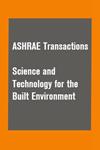Simulating the Electrical Demand Variations of Air-Source Heat Pumps in Canadian Single-Family Housing
IF 1.7
4区 工程技术
Q3 CONSTRUCTION & BUILDING TECHNOLOGY
Science and Technology for the Built Environment
Pub Date : 2023-07-10
DOI:10.1080/23744731.2023.2234226
引用次数: 0
Abstract
Heat pumps offer an efficient electrification of space heating but can significantly vary the magnitude and duration of house-level electrical demand, especially when replacing fuel-fired heating systems. This paper uses a simulation-based approach to simulate the electrical demand variations of air-source heat pumps (ASHPs) in six Canadian cities (Halifax, Montreal, Toronto, Winnipeg, Vancouver, Whitehorse) when replacing natural gas or electric baseboard heating. Detailed housing models (including a highly zoned model capturing room-based baseboard controls) are combined with a series of custom non-HVAC load profiles and an enhanced data-driven ASHP model to assess the variation that occupancy, climate, and type of heat pump integration can have on electrical demand. ASHPs are shown to increase the magnitude and duration of electrical demand when replacing natural gas furnaces, although selection of climate-appropriate systems (e.g. cold climate units in colder climates) may reduce the magnitude and coincidence of this demand. Where heat pumps replace electric baseboards, HVAC demand may decrease by up to 3.4 kW during ASHP operating periods and remain equal when the ambient temperatures are below the ASHP cutoff. A study of simple mitigation measures through varying temperature setpoints demonstrates the ability of proper controls to reduce electrical demand during high-demand periods.加拿大单户住宅空气源热泵用电需求变化模拟
本文章由计算机程序翻译,如有差异,请以英文原文为准。
求助全文
约1分钟内获得全文
求助全文
来源期刊

Science and Technology for the Built Environment
THERMODYNAMICSCONSTRUCTION & BUILDING TECH-CONSTRUCTION & BUILDING TECHNOLOGY
CiteScore
4.30
自引率
5.30%
发文量
78
期刊介绍:
Science and Technology for the Built Environment (formerly HVAC&R Research) is ASHRAE’s archival research publication, offering comprehensive reporting of original research in science and technology related to the stationary and mobile built environment, including indoor environmental quality, thermodynamic and energy system dynamics, materials properties, refrigerants, renewable and traditional energy systems and related processes and concepts, integrated built environmental system design approaches and tools, simulation approaches and algorithms, building enclosure assemblies, and systems for minimizing and regulating space heating and cooling modes. The journal features review articles that critically assess existing literature and point out future research directions.
 求助内容:
求助内容: 应助结果提醒方式:
应助结果提醒方式:


